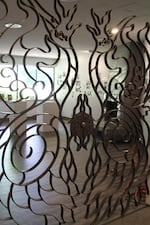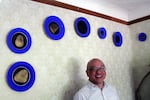Oregon is one of America's maker hubs — a place where quilters, game developers, wood carvers, sneaker designers and many more mix it up in an ecosystem built around hand work. Even the state's best-known exports, like beer and coffee, are branded as a craft.
But the downfall of Oregon College of Art and Craft, which held its final commencement Sunday, has left many in the creative community deeply shaken. One of the last remaining craft-focused degree programs in the country — and one of the West Coast's finest studio schools — had been on shaky ground for some time. But craft lies near to the region's identity that many didn't believe it could fail.
A Response For An Industrialized World

An elaborately worked gate inside the Hoffman Gallery at Oregon College of Art and Craft.
April Baer / OPB
The Arts and Crafts Society of Portland was founded in 1907 by artist and philanthropist Julia Hoffman, part of an international movement reacting to changes brought on by the Industrial Revolution.
The textbook definition of craft is decorative art defined by its relationship to functional, everyday things. Craft disciplines encompass the making of furniture and buildings, but also 1,000-year-old disciplines like ceramics, weaving, wood carving, jewelry making, and other artifacts of daily life.
But as Abby McGehee, the art historian at OCAC and department head for general studies, says, in Western scholarship "craft and art were not really distinct categories until the Renaissance."
Landmark products of Western civilization — McGehee points to Gothic cathedrals — are integrated works of art and craft. "Craft people," McGehee says, "like stained glass artists, were the great painters of the Middle Ages. There [was] no division there." But everything changes with the Industrial Revolution, as the average person's clothes, crockery, tools and toys were no longer made by skilled artisans, but by machines.
The art world reaction gave rise to designers like William Morris, preaching a gospel of handmade art products, affordable for everyone. The subsequent arts and crafts movement spread to Germany and Austria, giving rise to the Wiener Werkstätte, the Bauhaus, and scores of related institutions.
A Cascadian Craft Ethic
The Northwest was changed by the movement, from the Cascadian architecture of Timberline Lodge to craftsman bungalows, to furniture from Northwest timber.

Built by the Works Progress Administration, Timberline Lodge encompassed the work of hundreds of craftsmen and women. Their woodwork, ironworks, weaving, and glass set a new standard for Cascadian ideals, strongly influenced by the Arts and Crafts movement.
Courtesy of Timberline Lodge
Even Evergreen State College, the birthplace of riot grrrl, can trace its lineage back through progressive models of education, including Black Mountain College, a haven for Bauhaus expats. The way that Black Mountain College Museum and Arts Center program director and curator Alice Sebrell explains it will no doubt sound familiar to all modern devotees of design thinking.
"The arts were central to a successful education at Black Mountain College," she says. "The idea was to help students become citizens of the world, equipped to solve problems. The thinking was in the arts, problem-solving is what it's all about."
But for all the progressive optimism of those times, craft spent many of the ensuing years removed from art. Elissa Auther, research and collections curator at the Museum of Arts and Design in New York, says the academic and commercial worlds have held craft with a certain condescension.
“That kind of hierarchy has existed for quite some time in the Western art world," Auther says, "and has negatively impacted craft and artists who are working with those mediums.”
But that’s changing, she says, with a contemporary generation of artists. From Judy Chicago’s 1970s painted china plates, to this year’s Whitney Biennial, where Jeffrey Gibson — an artist with Choctaw and Cherokee roots — is showing big, brilliant-colored textile works of contemporary and traditional materials.
Craft As Contemporary Art
Tanya Aguiñiga is a multi-disciplinary artist based in Los Angeles for whom craft is central.
“I started kind of realizing the power of craft when I began working with other communities outside of my own community,” Aguiñiga says, “really talking to people about like colonization and different techniques and materials that were put upon us.”
Watch: “Tension//Tensión”
Aguiñiga’s project, “Tension//Tensión” with artist Jackie Amézquita at a border fence in Douglas, Arizona, involves traditional backstrap looms — a technique dating back to the Bronze Age. Aguiñiga set the two artists’ looms on opposite sides of the fence, attached to each other. Each weaves with the tension provided by the other.
Aguiñiga has worked inside and outside formal institutions — she earned a degree from the Rhode Island School of Design. She says that while craft is holding its own in the contemporary art world, she's among those worried about where craft education is going, as smaller colleges with craft-specific programs fall. At the same time, she sees the established craft community struggling to find a more inclusive path that could bring new life and relevance.
“Everybody's trying to kind of catch up to what craft is turning into, and all these new conversations coming more into the forefront because of our current political situation,” Aguiñiga says. “I feel like because a lot of the institutions are so antiquated, they're not ready to deal with like the browning or the queering of craft. They're really falling behind, and kind of failing a lot of us.”
Demand For Craft Remains High

Adam (left) and Jason (right) Gorske, the owner's of Portland's DIY Bar, where crafters drink and make with equal enthusiam.
April Baer / OPB
Even as craft institutions confront the make-or-break questions for their survival, it’s clear craft is good business. If a trip to IKEA — with its ultra-affordable, ersatz-Danish modern design doesn’t convince you — go see the breezy, open workshop bar that opened on North Vancouver Avenue in Portland in 2017.
DIY Bar is the brainchild of brothers Adam and Jason Gorske. Customers pick from a menu of project options — from leather wallets to hex-nut bracelets to macrame plant hangers. Buy the supplies, pay a couple of extra bucks for a glass of wine or a pint, and you can drink and work at the bar’s big wooden workbenches.
“We wanted to make it as simple and least-intimidating as possible. It doesn’t matter how good or bad we are at art, everybody’s got creativity in them," Adam Gorske says.
The Gorskes have done so well with their first location, tucked between a big creative firm and an artisanal bakery, that they’re looking into a second location in Seattle.
We also stopped by the Spring Marketplace fair at Portland’s Native American Youth and Family Center, where Angel TwoBulls (Oglala/Lakota) and a friend sat behind a table, raising cash for the tuition in their Ph.D. studies at Oregon State’s school of psychology.
“My whole life I’ve been around people who make things,” TwoBulls told us, on a break from tabling. “My mom makes star quilts and a lot of cultural items. She also taught me to sew.”
In her life, being crafty was a response to scarcity. “I like DIY stuff and making things work. You get resourceful and use what’s around you.”
Although TwoBulls never took classes at OCAC, they feel the closure is a sobering loss, but not the end of craft in Oregon.

Angel TwoBulls, left, Leah Altman, center, and Chenoa Landry, right, at the Native American Youth and Family Center's Spring Marketplace.
April Baer / OPB
“Craft has been around pre-contact,” they laughed.
Long before settlers showed up in Oregon, Native people were putting decades of experience into their baskets, textiles and jewelry. Craft may continue to be something that industry tries to copy and capitalize. But it’s also something people do by themselves, for themselves.
Chenoa Landry (Puyallup) runs NAYA’s cultural arts program. Classes there range from project-specific, like red ribbon skirts honoring missing indigenous women, to instruction for foster kids. Native youth enter the foster system at much higher rates than other demographic groups and are prone to lose touch with their culture.
“We’re not a college by any means,” Landry said, “but we try to bring people who want to share their skills.”
While OCAC held its final commencement last weekend, NAYA was hosting another Spring Marketplace at the Rockwood Center in East Portland.
Saying Painful Goodbyes

The forested campus of Oregon College of Art and Craft is pictured in the waning weeks of its finals spring 2019 semester.
April Baer / OPB
As the college’s final semester wound down, staff and students said goodbye in different ways, including a closing party and a wake for the college’s library. The artists, students and teachers, who’ve come through OCAC — making jewelry, ceramics, hand-carved wood objects, sculpture and many other things — number in the thousands.
Fernanda D’Agostino is an artist living in Portland who has exhibited work all over the world — from digital art, to glass, to metals. Her entrée to the Pacific Northwest was an OCAC residency in 1985. She says, the loss of OCAC has dire implications for nearly every Oregon industry.
“If you go to Japan or Italy or [any] culture that has a very long-lasting and strong history of making things with a lot of care and attention, that sensibility doesn't only apply to the beautiful hand-painted platter,” D’Agostino says. “You can see that sensibility in the toothbrush that you buy in the Italian equivalent of Target. I feel like if we totally cut our ties with craft, the things that are made here will become less beautiful, less meaningful.”

Artist Horatio Law, with samples from his series, "China Wall". The plates, bearing photographic images, were inspired by Law's inquiry into the history of Chinese mine workers in Oregon.
April Baer / OPB
Artist Horatio Law, another alumnus of OCAC’s residency program, came to the college in 1994 just after graduate school. He’s taught at both OCAC and Pacific Northwest College of Art, Portland’s other standalone art school.
“Even though the focus is on the excellence of the craft, they never skimp on getting the student to think about concept, think about ideas,” he says.
Law, who is Chinese American, learned techniques at OCAC for a project that would consume him for several years. “China Wall” is a series of plates, in different shapes and sizes, each bearing a gleaming gold-on-black image of rocks Law photographed in Eastern Oregon framed by a striking cobalt-colored matte finish.
"I wanted the blue colors [to be] really intense," Law said. "That's where craft comes in. When your idea drives you to a look, how do you make it?"
Roberta Lavadour, executive director of the Pendleton Center for the Arts, mourns OCAC as the intellectual home of her studio practice: bookmaking.
“If you attend a national gathering of book artists,” she says. “You’re going to see a really strong representation of Oregon artists and people who’ve studied or taught at OCAC. In the same way I think of Crater Lake, I think of OCAC being an iconic part of Oregon.”
Metalsmith and jeweler Kristin Mitsu Shiga attended OCAC as a student, and worked there in several capacities over the years, as a staff member and instructor. "I came there with pretty good technical skills, but the big thing that I was really lacking was understanding how to create a body of work and how to find my voice," she says.
The intimate experience of learning at OCAC, she says, made those things possible. She also remembers a milestone: the metalsmithing program’s teapot project.
“It was the only program in the United States that still required to hollowware component of finished, functional teapot,” Shiga said. While functionality sometimes carries dirty word connotations in the art world, Shiga says, OCAC still embraced it: how could objects contribute? If a thing didn’t function, what did that mean to its narrative?
“My teapot took me nine months to make,” she remembers, “And I barely finished it. It has over a hundred solder seams. It required me to use two torches at once on sterling silver, which cost more than my car at the time. But it was a great way to push myself technically.”
The Beginning Of The End
Shiga went on to become an instructor and board chair at Haystack Mountain School of Crafts in Maine. OCAC never had a particularly easy road financially. But Shiga notes the challenge of keeping the school afloat took on a very specific flavor when OCAC shifted from a studio school to an accredited college.
“I was there during the accreditation. It's a ton of work and the infrastructure that is needed to run the degree programs — supporting the students required investment of time and money. So really it became a much bigger machine,” she says.

Attendees peruse the final exhibition at Oregon College of Art and Craft's Hoffman Gallery on Saturday, May 18, 2019.
April Baer / OPB
The college has had several near-death experiences over the years. OCAC's board declined to speak with OPB about any aspect of the closure, or OCAC's history. But those close to the school say operational funding for the collegiate program was always hard to come by, and over time, board members and presidents approved dipping into the school's endowment, 'till there wasn't much left.
Shiga says: "My heart really goes out to the faculty and staff and current students. I can't imagine how devastating this is for them. One of my first thoughts is, 'Oh my God, what are they going to do?' My second thought was, I feel like the current board is left holding the bag in a way. I'm not saying I agree with all the decisions they've made, but I appreciate the fact that their decisions must be incredibly difficult. They're bearing the results of things that really they didn't put into motion."

